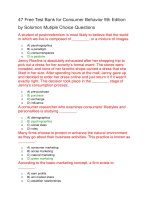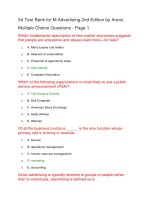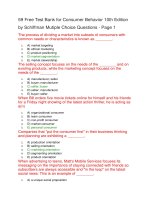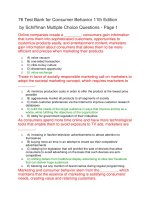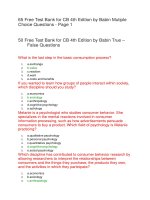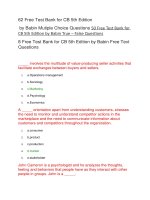90 test bank for consumer behavior 2nd edition by babin
Bạn đang xem bản rút gọn của tài liệu. Xem và tải ngay bản đầy đủ của tài liệu tại đây (107.28 KB, 16 trang )
90 test Bank for Consumer Behavior 2nd Edition by
Babin
Mutiple Choice Questions
Which of the following is NOT a discipline in which
consumer behavior has roots?
1.
2.
3.
4.
5.
a.Economics
b.Accounting
c.Anthropology
d.Social psychology
e.Sociology
Which of the following is based on the belief that firm
performance is enhanced through repeat business?
1.
2.
3.
4.
5.
a.acquisition marketing
b.outward marketing
c.inward marketing
d.repetition marketing
e.relationship marketing
Harold is hungry and decides that a hamburger will satisfy
him. The hamburger is an example of a(n) _____.
1.
2.
3.
4.
5.
a.need
b.want
c.reaction
d.outcome
e.satisfier
Which type of research includes tools such as case
analyses, clinical interviews, focus group interviews,
and other tools in which data are gathered in a
relatively unstructured way?
1.
2.
3.
4.
5.
a.quantitative research
b.qualitative research
c.soft research
d.preliminary research
e.secondary research
Obtaining resources from consumers in return for the value
they create is a basic tenet of _____, which is a theory
explaining why companies succeed or fail.
1.
2.
a.attribution theory
b.resource-advantage theory
3.
4.
5.
c.the marketing concept
d.the theory of reasoned action
e.resource-elaboration theory
_____ can be defined from two different perspectives: human
thought and behavior and as a field of study.
1.
2.
3.
4.
5.
a.Marketing
b.Consumer behavior
c.Economics
d.Ethnography
e.Consumption
Erin is engaged in research that seeks to explain the inner
meanings and motivations associated with purchasing
home furnishings. She interprets meaning through the
words that consumers use to describe events or
through observations of consumers shopping in
furniture stores. What type of research is Erin
performing?
1.
2.
3.
4.
5.
a.quantitative research
b.interpretive research
c.soft research
d.sociological research
e.independent research
Which discipline has contributed to consumer behavior
research by allowing researchers to interpret the
relationships between consumers and the things they
purchase, the products they own, and the activities in
which they participate?
1.
2.
3.
4.
5.
a.economics
b.sociology
c.anthropology
d.cognitive psychology
e.astrology
_____ can be thought of as negative results of consumption.
1.
2.
3.
4.
5.
a.Wants
b.Reactions
c.Costs
d.Benefits
e.Consequences
Offering the same basic product to all customers is which
type of business orientation?
1.
2.
3.
4.
5.
a.undifferentiated marketing
b.differentiated marketing
c.niche marketing
d.product marketing
e.production marketing
What is the difference between qualitative and quantitative
research?
1.
2.
3.
4.
5.
a.Qualitative research is used for hypothesis testing, and quantitative research is
only used for descriptive analyses.
b.Quantitative research is longitudinal, and qualitative research is cross-sectional.
c.Qualitative research is researcher dependent, and quantitative research is not.
d.Quantitative research is researcher dependent, and qualitative research is not.
e.Quantitative research results in primary data, and qualitative research results in
secondary data.
The physical parts of a product are known as _____.
1.
2.
3.
4.
5.
a.benefits
b.elements
c.attributes
d.resources
e.components
Which orientation refers to a way of doing business in which
the actions and decision making of the institution
prioritize consumer value and satisfaction above all
other concerns?
1.
2.
3.
4.
5.
a.product orientation
b.production orientation
c.consumer orientation
d.sales orientation
e.benefit orientation
Melanie is a psychologist who studies consumer behavior.
She specializes in the intricacies of mental reactions
involved in consumer information processing. Which
field of psychology is Melanie practicing?
1.
2.
3.
4.
5.
a.qualitative psychology
b.personal psychology
c.quantitative psychology
d.cognitive psychology
e.social psychology
The ultimate hallmark of success for a business is _____.
1.
2.
3.
4.
5.
a.maximum profits
b.maximum sales
c.long-term survival
d.short-term sales
e.monopoly
Juan is majoring in a discipline that is often defined as the
study of production and consumption. Which of the
following best describes Juan’s major?
1.
2.
3.
4.
5.
a.Economics
b.Accounting
c.Anthropology
d.Psychology
e.Production management
Marketing as a recognized discipline grew out of which two
other disciplines?
1.
2.
3.
4.
5.
a.economics and psychology
b.economics and accounting
c.psychology and anthropology
d.psychology and sociology
e.sociology and economics
The field of psychology that focuses on the thoughts, feeling
and behaviors that people have as they interact with
other people (group behavior) is known as _____.
1.
2.
3.
4.
5.
a.qualitative psychology
b.group psychology
c.quantitative psychology
d.cognitive psychology
e.social psychology
Which discipline focuses on the study of groups of people
within a society?
1.
2.
3.
4.
5.
a.economics
b.sociology
c.anthropology
d.cognitive psychology
e.astrology
What is the last step in the basic consumption process?
1.
2.
a.exchange
b.value
3.
4.
5.
c.reaction
d.want
e.costs and benefits
_____ involves the multitude of value-producing activities
that facilitate exchanges between buyers and sellers.
1.
2.
3.
4.
5.
a.Consumption
b.Consumer behavior
c.Marketing
d.Psychology
e.Economics
Procter & Gamble sells six different brands of laundry
detergent, each with a unique offering for different
market segments. Which business orientation does
this illustrate?
1.
2.
3.
4.
5.
a.undifferentiated marketing
b.differentiated marketing
c.niche marketing
d.product marketing
e.multiple marketing
_____ represents the process by which goods, services or
ideas are used and transformed into value.
1.
2.
3.
4.
5.
a.Value transfer
b.Cost conversion
c.Benefits conversion
d.Consumption
e.Marketing
Two factors should be considered when trying to understand
how important serving customers well should be to
any given organization. The first factor is the
competitiveness of the marketing environment, and
the second is the _____.
1.
2.
3.
4.
5.
a.price charged for the product or service
b.income level of customers
c.social impact
d.dependency of the marketer on repeat business
e.objectives of the marketer
Some marketers offer each individual customer a different
product, so each customer is essentially treated as a
segment of one. Which way of doing business does
this represent?
1.
2.
3.
4.
5.
a.undifferentiated marketing
b.personalized marketing
c.customer-based marketing
d.one-to-one marketing
e.niche marketing
Which of the following is NOT a trend shaping the value
received by consumers today?
1.
2.
3.
4.
5.
a.internationalization
b.technological changes
c.market compression
d.changing demographics
e.all of the above are trends shaping the value received by consumers today
Lane Bryant is a women’s clothing store specializing in
stylish clothing and flattering fits for plus-sized
women. Which business orientation best describes
Lane Bryant’s approach?
1.
2.
3.
4.
5.
a.niche marketing
b.one-to-one marketing
c.mass marketing
d.product marketing
e.undifferentiated marketing
The first step in the basic consumption process is _____.
1.
2.
3.
4.
5.
a.cost and benefit analysis
b.reaction
c.value assessment
d.want specification
e.need realization
Charles works in a company that has a culture that embodies
the importance of creating value for customers among
all employees. Which type of orientation does his
company embrace?
1.
2.
3.
4.
a.market orientation
b.product orientation
c.production orientation
d.sales orientation
5.
e.outward orientation
The acting out of a decision to give something up in return
for something of greater value is known as _____.
1.
2.
3.
4.
5.
a.exchange
b.marketing
c.consumption
d.consumer behavior
e.phenomenology
When consumers study consumer behavior, they should
come to make better decisions. Which of the following
can be helpful in enlightening consumers?
1.
2.
3.
4.
5.
a.Consequences associated with poor budget allocation.
b.The role of emotions in consumer decision making.
c.Avenues for seeking redress for unsatisfactory purchases.
d.The effect of the environment on consumer behavior.
e.All of the above.
Which of the following is a demographic trend shaping
consumer behavior patterns?
1.
2.
3.
4.
5.
a.family size is increasing
b.households increasingly include two primary income providers
c.birthrates are increasing in the U.S. and Europe
d.lower levels of consumer affluence in the U.S.
e.decreasing life expectancy in the U.S.
_____ research addresses questions about consumer
behavior using numerical measurement and analysis
tools.
1.
2.
3.
4.
5.
a.Quantitative
b.Qualitative
c.Interpretive
d.Initial
e.Final
_____ refer to direct contacts between the firm and a
customer.
1.
2.
3.
4.
5.
a.Touchpoints
b.Intersections
c.Interaction points
d.Moments of truth
e.Counterpoints
The study of human reactions to their environment is known
as _____.
1.
2.
3.
4.
5.
a.marketing
b.economics
c.psychology
d.anthropology
e.sociology
True - False Questions
Marketing is often defined as the study of production and
consumption.
1.
2.
True
False
Interpretive research seeks to explain the inner meanings
and motivations associated with specific consumption
experiences.
1.
2.
True
False
Value transfer is the acting out of a decision to give
something up in return for something of greater value.
1.
2.
True
False
The roots of interpretive consumer research go back over
150 years to the earliest days of consumer research.
1.
2.
True
False
Costs involve more that just the price of the product.
1.
2.
True
False
The basic consumption process begins with an assessment
of costs and benefits associated with a choice.
1.
2.
True
False
Trends shaping the value received by consumers include
internationalization, technological changes, and
changing demographics.
1.
True
2.
False
Marketing activities include the production, promotion,
pricing, and distribution of goods, services, ideas, and
experiences that provide value for consumers and
other stakeholders.
1.
2.
True
False
There is no single best way of studying consumer behavior.
1.
2.
True
False
Consumer behavior can be defined from three different
perspectives.
1.
2.
True
False
Interaction points refer to direct contacts between the firm
and a customer.
1.
2.
True
False
A consumer orientation is a key component of a firm with a
market oriented culture.
1.
2.
True
False
Psychology is the study of human reactions to their
environment.
1.
2.
True
False
A market orientation means innovation is geared primarily
toward making the production process as efficient and
economic as possible.
1.
2.
True
False
Data generated from qualitative research are considered
“researcher-dependent.”
1.
2.
True
False
Benefits are the only result of consumption.
1.
2.
True
False
Customs, manners and rituals all involve consumption-value
producing activities.
1.
2.
True
False
One theory explaining why companies succeed or fail is
resource-advantage theory.
1.
2.
True
False
Two common interpretative orientations are phenomenology
and ethnography.
1.
2.
True
False
The phenomenological researcher relies on highlystructured, formal interviews with consumers.
1.
2.
True
False
A want is simply a specific desire that spells out a way a
consumer can go about addressing a recognized
need.
1.
2.
True
False
One demographic trend impacting marketers is that
households increasingly include two primary income
providers.
1.
2.
True
False
The Internet has made geographical distance almost a nonissue.
1.
2.
True
False
Anthropology focuses on the study of groups of people
within a society.
1.
2.
True
False
One perspective of consumer behavior is that it refers to
human thought and action.
1.
2.
True
False
Consumer behavior represents the process by which goods,
services, or ideas are used and transformed into
value.
1.
2.
True
False
Relationship marketing is based on the belief that firm
performance is enhanced through repeat business.
1.
2.
True
False
Companies must deal only with geographical distances
when operating in different countries.
1.
2.
True
False
Quantitative research data are “researcher-dependent.”
1.
2.
True
False
Quantitative research tools include things such as cases
analyses, clinical interviews, focus group interviews
and other tools in which data are gathered in a
relatively unstructured way.
1.
2.
True
False
Undifferentiated marketers generally adopt a market
orientation.
1.
2.
True
False
A highly competitive marketplace in which consumers have
many alternatives practically insures poor customer
service.
1.
2.
True
False
The motivational research era in consumer research proved
to be very useful in providing satisfying explanations
for consumer behavior on a large scale.
1.
2.
True
False
Quantitative research addresses questions about consumer
behavior using numerical measurement and analysis
tools.
1.
2.
True
False
Undifferentiated marketing means that the same basic
product is offered to all customers.
1.
2.
True
False
One demographic trend shaping consumer behavior is the
rising birth rates in the U.S. and Europe.
1.
2.
True
False
Cognitive psychology deals with the intricacies of mental
reactions involved in information processing.
1.
2.
True
False
An understanding of consumer behavior can mean better
business for companies, better public policy for
governments, and a better life for individuals.
1.
2.
True
False
Benefits are the physical parts of a product.
1.
2.
True
False
Consumer behavior can be thought of as the actions,
reactions and consequences that take place as the
consumer goes through a decision making process,
reaches a decision and then uses the product.
1.
2.
True
False
Product orientation refers to an organizational culture which
embodies the importance of creating value for
customers among all employees.
1.
2.
True
False
Consumer behavior can be defined as a field of study that is
developing an accumulated body of knowledge.
1.
2.
True
False
Anthropology focuses on the thoughts, feelings and
behaviors that people have as they interact with other
people.
1.
2.
True
False
Niche marketers serve multiple market segments.
1.
2.
True
False
The final step in the consumption process is value.
1.
2.
True
False
Consumer behavior, as a field of study, is a very old field.
1.
2.
True
False
Consumer behavior has family roots in other disciplines
such as economics, anthropology, and psychology.
1.
2.
True
False
Differentiated marketing can be taken to the extreme with a
practice known as one-to-one marketing.
1.
2.
True
False
A product is a potentially valuable bundle of benefits.
1.
2.
True
False
Qualitative research better enables researchers to test
hypotheses as compared to quantitative research.
1.
2.
True
False
Free Text Questions
Compare and contrast the concepts consumption and
consumer behavior.
Answer Given
Consumer behavior can be defined from two different perspectives. This is
because the term refers to both: 1. Human thought and action, and 2. A field of
study (human inquiry) that is developing an accumulated body of knowledge. First,
consumer behavior is the set of value seeking activities that take place as people
go about addressing realized needs. Consumption represents the process by
which goods, services, or ideas are used and transformed into value. Consumer
behavior as a field of study represents the study of consumers as they go about
the consumption process.
Explain the role of consumer behavior in business and
society.
Answer Given
Consumer behavior (CB) is important in at least three ways: 1. CB as an input to
business/marketing strategy; 2. CB as a force that shapes society; 3. CB as an
input to making responsible decisions as a consumer. Consumer behavior
influences the way a company will do business. Undifferentiated marketing means
that the same basic product is offered to all customers. Differentiated marketers
serve multiple market segments each with a unique product offering. Niche
marketing is practiced by firms that specialize in serving one market segment with
particularly unique demand characteristics. Understanding customers and
potential customers guides marketers to the appropriate way of doing business for
a given situation. The things that people buy and consume end up determining the
type of society in which we live. Things like customs, manners, and rituals all
involve consumption-value producing activities. Therefore, our collective choices
as consumers shape the societies in which we live. Finally, when consumers study
consumer behavior, they should come to make better decisions. Several topics
can be particularly helpful in enlightening consumers including: 1. Consequences
associated with poor budget allocation; 2. The role of emotions in consumer
decision making; 3. Avenues for seeking redress for unsatisfactory purchases; 4.
Social influences on decision making, including peer pressure; 5. The effect of the
environment on consumer behavior.
Explain why consumers get treated differently in different
types of exchange environments.
Answer Given
Two questions help explain how important serving customers well should be to
any given organization: 1. How competitive is the marketing environment?; 2. How
dependent is the marketer on repeat business?; A business operating in a market
with little or no competition and a captive audience can still survive no matter how
poor the service because they know consumers will return to do more business if
that is the only option available (e.g., driver’s license bureau). On the other hand,
a business operating in a highly competitive marketplace in which consumers
have many alternatives practically insures good customer service.
Briefly discuss some recent trends shaping consumer
behavior.
Answer Given
Three trends shaping the value received by consumers today are discuss in the
chapter: (1) internationalization, (2) technological changes, and (3) changing
demographics. While businesses are expanding worldwide, companies must deal
not only with geographical distances, but with cultural distances as well. Although
chains, such as Starbucks, can be found worldwide, consumers are not alike
everywhere these firms operate. The Internet has made geographical distance
almost a non-issue, consumers can shop on his or her own schedule, and
communication technology has also advanced tremendously. Finally, in most of
the western world, notable demographic trends have shaped consumer behavior
patterns greatly. First, households increasingly include two primary income
providers. Second, family size is decreasing throughout the U.S. and Europe. The
combination of working couples and lower birth rates has led to greater levels of
consumer affluence. Further, the growth trends in population affect the consumer
culture in many ways. One major issue in the U.S. today is the aging baby-boomer
population, which should affect business practices for many years to come.
Compare and contrast qualitative research and quantitative
research.
Answer Given
Qualitative research and quantitative research are two different approaches for
studying consumer behavior. Qualitative research tools include things such as
case analyses, clinical interviews, focus group interviews and other tools in which
data are gathered in a relatively unstructured way. Data of this type requires that
the researcher interprets its meaning. Therefore, the data are considered
“researcher-dependent.” Interpretive research, which seeks to explain the inner
meanings and motivations associated with specific consumption experiences, falls
into the category of qualitative research. Quantitative research addresses
questions about consumer behavior using numerical measurement and analysis
tools. The measurement is usually structured, meaning that the consumer will
simply choose a response from among alternatives supplied by the researcher.
Unlike qualitative research, the data are not researcher dependent. This type of
research better enables researchers to test hypotheses as compared to
interpretive research. Quantitative research is more likely to stand on its own and
not require deep interpretation.
